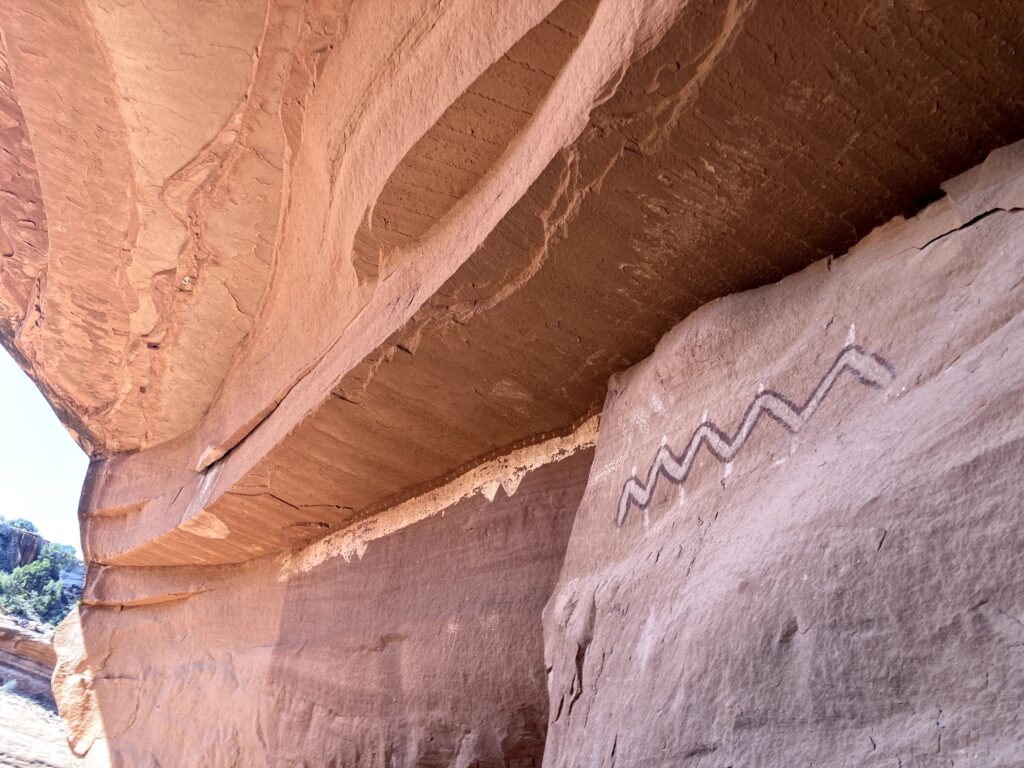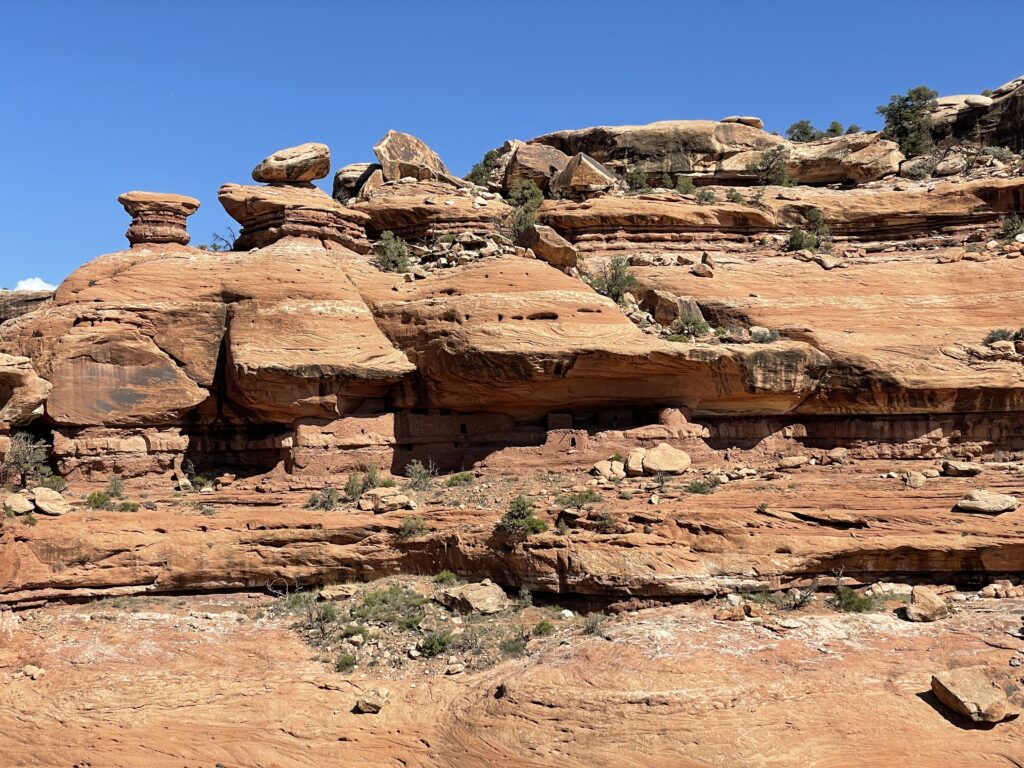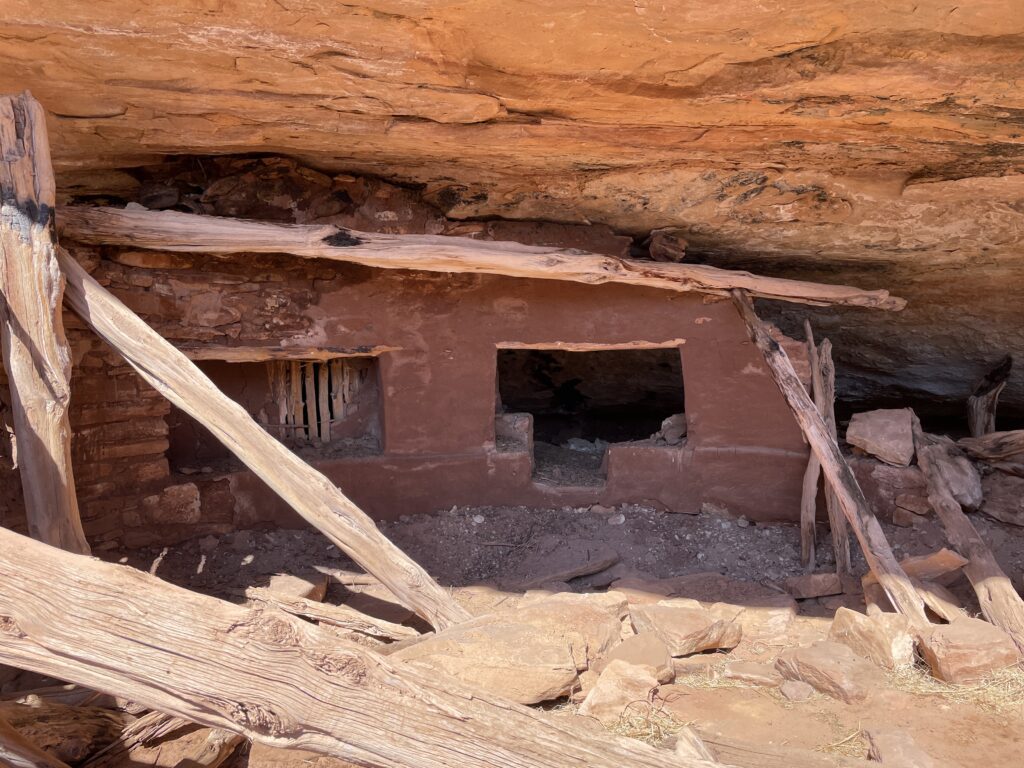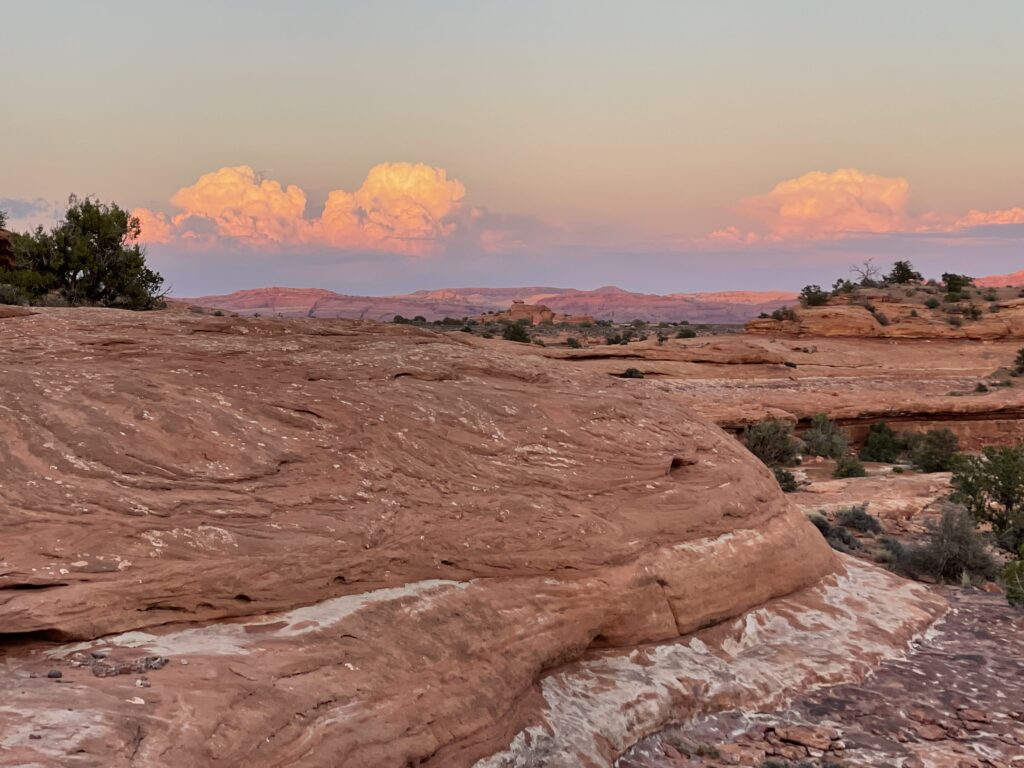Last Updated on February 27, 2024 by foxintheforest
If you’re looking for a stunning desert hike to an exceptional historic site, look no further than the Moon House Ruins. As one of the easier and larger Anscesteral Puebloan sites in the Cedar Mesa Region, the Moon House is a must-see.
Located within the Bears Ears National Monument, the Moon House requires a short, but steep hike and a permit to visit. There are 3 separate ruins to view with over 49 well-preserved rooms. It’s a fantastic site with refuse piles, a kiva, painted walls, pictographs, and moki steps. If you’ve got a keen eye, you may spot some potsherds.
If you’re looking to visit the Moon House like a seasoned pro, not a tourist, then you’re in the right place.
About This Guide to the Moon House Ruins
Inside this expert guide to visiting the Moon House you’ll find:
- Pondering the history of the Moonhouse
- Detailed instructions for how to reach the Moon House
- Snagging a permit for the Moon House
- Practical info for visiting
- How to reach the ruins via the Moon House Trail
- Where to camp
- Practical tips for visiting
- Things to do nearby
- Additional desert resources

What is the Moon House?
The Moon House is a large cliff dwelling located in the Cedar Mesa area of Bears Ears National Monument. It’s one of the largest cliff dwellings that’s still around in Cedar Mesa. The consensus is around 25 to 35 people called this place home at one time.
There are different types of rooms that are influenced by different peoples of the area. The BLM believes that there were three different building periods: 1242-1244 AD, 1249-1254 AD, an 1256-1264 AD.
You’ll see Jacal (pronounced “ha-kal”) construction that utilizes wooden poles, mud, and yucca strips.
Looking inside the structure (you shouldn’t enter) you can see the soot from cook fires and even painted walls where the Moon House gets its name.
The far northwest of the site has plenty of pictographs and refuse piles while the far southeast has steep moki steps that scale the canyon walls.
The kiva has collapsed in modern times, but you can still see the signature poles that once made up the roof.
One of the more interesting aspects of the site is the corridor. Here you’ll see 27 distinct holes that look out to various viewpoints in the canyon below. These were thought to be used for surveillance and protection in the area.
No one really knows what happened to cause the decline of the Ancestral Puebloans. However, the modern-day people of the Ancestral Puebloans – the Hopi, the Rio Grand Pueblo, and the Zuni still live on today.
How Do I Get to the Moon House Ruins?
In order to reach the Moon House Ruins, you’ll need to reach the trailhead. There are a couple of things to keep in mind. First, you’ll need to pick up your permit at the Kane Gulch Ranger Station before you visit. Second, you’ll need a 4×4 vehicle with high clearance (stock 4Runner was more than fine) to reach the trailhead parking lot.
From the junction of UT 95 and UT 261, drive south on UT 261 for about 4 miles. You’ll see the Kane Gulch Ranger Station on the left side of the road. After snagging your permit, continue down the road for another 6 miles. You’ll see a turn for Snow Flat Road.
Turn left on Snow Flat Road. You’ll pass a BLM map. Afterward, veer left at a small sign marked “trail.”
Continue down the road for 3.5 miles. From here, the road is more of a 4×4 road. You can pull over and park if you don’t have the clearance. This will add 9 miles RT to your hike. You’ll reach the trailhead at 8 miles in.
Pro Tip: This area is REMOTE be prepared to self-rescue and be on your own. Pack out all trash, including human waste.

Obtaining a Permit for the Moon House
Visiting the Moon House between March 1 to June 15 or September 1 to October 31 you’ll need to obtain a permit. Permits are available in advance through recreation.gov. There are only 20 visitors allowed to visit per day.
As one of the best hikes in Utah (in my opinion), navigating the permit system is worth it for this one.
We went in on a random weekend in October and had no issues getting a permit. We were actually the only people at the site all day. As we were walking out late in the afternoon, we saw 2 other groups at the trailhead.
You cannot camp at the trailhead or near the ruins. This is a day-trip-only situation. But don’t worry, there is great dispersed camping nearby.
Practical Info for Visiting
There are a few important things to know when visiting the Moon House Ruins. Here’s a look at practical trail info for your visit.
Total hiking mileage: 4.4 miles – out and back. It’s more of a T-shape.
Elevation Gain: 636 feet
Difficulty: Moderate
Estimated Time: 5 hours gives you plenty of time to enjoy the ruins.
Dog-friendly: No dogs are allowed in Cedar Mesa.
Red Tape: Permits are required to visit. 4×4 is required to reach the trailhead.
It is a FEDERAL FELONY to remove artifacts, vandalize, or climb ruins. Leave it better than you found it, this includes your trash. Report bad behavior.

What are the Coordinates for the Moon House?
The parking coordinates are: 37 ° 25′ 06″ N; 109 ° 48′ 09″ W
The ruin can be found at: ruin: 37 ° 26′ 08″ N; 109 ° 47′ 30″ W There are several sites along the canyon rim to visit, but you can see them all as you descend down the first canyon wall.
Respectfully Visiting the Moon House
You’re visiting the history of an entire nation of people. In fact, some of the modern-day tribes consider Ancestral Puebloan ruins to be sacred graves that should be completely left alone. It’s actually controversial in some minds to visit these sacred sites. Visit with respect.
You will want to pack out all trash, including human waste. This means bringing a WAG bag for number 2’s. If you’re not cozy with this, consider visiting when you are more comfortable.
Dogs are not allowed at the Moon House Ruins
Do not take artifacts, even dirt. Don’t climb the walls or enter any structures that you would have to touch to get in. Your impact will last a long, long time. Again, it’s a felony to do this.
Unlike other sites located in Cedar Mesa, the Moon House had shockingly little potsherds – or pieces of pottery. These are frequently found on the ground near ruins. This leads me to believe that the site has had its fair share of robbers and pick-pockets. Don’t be that person.
The desert is a fragile, dangerous place after rain. Roads can become exceptionally dangerous and flash floods are a huge safety hazard. Use weather.gov to check the weather at the Moon House Ruins prior to your visit.

Reaching the Moon House Ruins
You’ll need to hike down and up a canyon to reach the Moon House Ruins. However, the trail is relatively straightforward. It’s not as obvious as say – a national park – but if you’ve done any type of hiking deep in the desert, navigation is not an issue.
For reference, I did this hike pregnant and had zero issues.
Look for cairns and follow the path of least resistance.
Canyon Decent
Right from the trailhead you’ll start to descend into McCloyd Canyon. The trail gets steeper as you reach the rim. Follow the cairns down a rocky, somewhat loose route. You’ll need to scramble over a few bits (you’ll be using your hands) but it isn’t anything too precarious.
Curve around a slickrock amphitheater section and slid down a lip using the cairns to guide you. Coming back up, is the hardest part.
You’ll switch back down the canyon. If you stop and look at the opposite wall, you’ll be able to spot the Moon House Ruins.

Hiking Up to the Ruins
Once you reach the bottom of the canyon at 1.6 miles, you’ll follow a trail along the canyon floor, circumnavigating some large boulders.
From here you’ll turn right, aiming for the other canyon. Stay to the left of the obvious pour-off and you’ll spot a trail heading up the other side of the canyon.
Ascend the trail, picking your way through a tier of slickrock. You’ll need to climb up a slabby crack to the base of the Moon House before you reach your final destination. Another 1.7 miles.
What to See
You’ll spot an ammo can. In here you can read about the Moon House Ruins and what to see.
You can enter the hallway through the main doorway – just be sure not to pull on the walls. You cannot enter any of the other rooms.
You’ll spot pictographs, sooty roofs, and intricately painted walls that give the Moon House its name.
Pro Tip: Having a headlamp helps explore the interior of the ruins.
On the far end of the site, there is a sweet slickrock ledge that’s perfect for a snack break (pack out your trash). Here you’ll see corn cobs, refuse piles, and rock art.
Come back the way you came and continue along the slick rock shelf to see a few other smaller structures (likely granaries or storage. You’ll eventually reach a huge boulder. On the left side of the boulder is a series of impressive moki steps that make their way up the steep cliffside.
What it must have been like to climb up and down those!

Camping Near the Moon House
Although you cannot camp at the trailhead, there are several amazing dispersed campsites along Snow Flat Road. We camped in an area called The Twist and it was incredible – didn’t see another soul all weekend. Our pop-up camper (lifted) managed to make it here with minor issues. We had a pretty hardcore water crossing.

What are the Best Ruins in Cedar Mesa?
Aside from the Moon House Ruins, other popular ruins include the Target House Ruins. There is so much out here – most of it obscure and only accessible by multi-day backpacking. However, a trip into the backcountry in Cedar Mesa (permit required) is well worth it!
What to See Nearby
There are a lot to do nearby. Other adventures in the area include:
- Backpacking Bullet Canyon
- Backpacking Fishcreek Canyon
- Camping at Valley of the Gods
- Stopping at the roadside ruins along Comb Ridge
- Monument Valley – a great stop along any Denver to Grand Canyon road trip.
- Cosmic Ashtray (if you don’t mind a bit of a drive)
Additional Expert Utah Travel Resources
Looking to explore the best of the American Southwest like an expert, not a tourist? Then you’re in the right place – check out these amazing resources:
